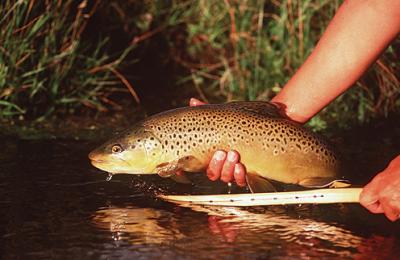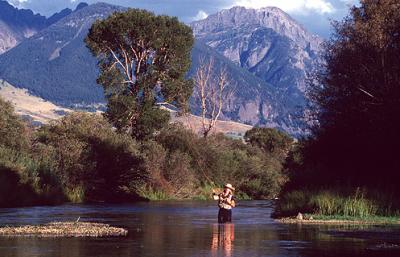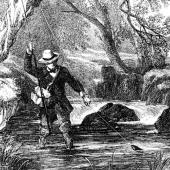Fishing Spring Creeks
The Big Sky's Distinguished Waters...
The April morning held promise as I wound my way north on Highway 91 through wide open meadows and hay fields, in search of a new fishing experience. Winter had finally released its grip on the Beaverhead Valley. With a warm and gentle breeze, Spring had announced its arrival.

Five miles outside Dillon, a sign welcomed me to the McCoy Ranch and Spring Creeks. Eager as I was to get to the creek itself, the bobbing tail of an American kestrel and the silky flight of a rough legged hawk slowed my approach along the bumpy half-mile dirt road that leads to the fishing shack.
I heard a song of fecundity--the call of the western meadowlark, my first of the season. It would be a good day.
Wearing a welcoming smile, Steve Beilenberg greeted me from the cedar porch of the shack. Introductions exchanged, we jumped in his old beater of a truck and snaked our way through a sea of Red Angus cows. It didn’t take long for me to realize that I was in the presence of a sage. A longtime fishing guide and manager of the McCoy Spring Creeks, Steve displayed an uncanny knowledge of each hole as he introduced me to them.
The water was clear, the riffles slow, and the holes deep. The lofty peaks of the Pioneer Mountains, still covered in snow, framed the landscape, and the first trout of the day bubbled to the surface, welcoming the onset of the midge hatch.
Mention “Montana” and the words “fly-fishing” soon follow. Montana is home to some of the most famous trout rivers in the country, names that conjure up fishing bliss for anglers all over the world: the Yellowstone, Madison, Bighorn, Beaverhead, Bighole, Clark Fork, Missouri, and Bitterroot.
Lesser known, but equally worthy of fly-fishing acclaim, are Montana’s pristine and bountiful spring creeks.
It is the richness of spring creeks that sets them apart from the tail-water fisheries (rivers that flow below a dam) and freestones (rivers without any dam). Several factors contribute to that richness. Unlike Montana’s more famous rivers that depend upon snowfall, spring runoff, and rain for their water supply--thus fluctuating dramatically in water level each season—spring creeks are fed from groundwater that arises continuously throughout the year, making them almost monotonous in their predictability. Yet the challenge they offer may be their greatest appeal. According to Robert Gary, of the River Otter Fly Shop in Florence, “the complexity of Montana’s spring creeks make them the graduate school of trout fishing.”

Fish don’t like change. It disrupts their feeding habits. Along with fluctuations in water level and clarity, temperatures in freestone rivers like the Yellowstone fluctuate drastically throughout the year, from the mid 30’s in Winter to the high 60’s in Summer. Spring creeks in Montana, however, maintain a stable water flow, clarity, and temperature -- hovering around the 52-degree mark throughout the year. The consistency provides optimum year round breeding grounds for the aquatic insects trout feed upon. The fish grow accordingly. Further enriching the water is the fact that most of Montana’s spring creeks flow over a layer of Paleozoic Madison Limestone -- rock rich in calcium carbonate, which percolates into the creek, adding nutrients.
Each of Montana’s spring creeks is unique in terms of setting, culture, and history.
Craig Mathews, owner of Blue Ribbon Fly Shop in West Yellowstone, Montana, has been fishing the spring creeks of Montana since 1970. Craig confesses his love for these fisheries: “When you take a look at the mountain range that towers over you while fishing one of the best pale morning dun hatches you will ever see, the fishing experience becomes a total wilderness experience, and it’s breathtaking.”

And then there are the stories and history of the people who occupy ranches bisected by spring creeks, which are as varied and rich as the waters themselves. Spring creeks are most often located on private ranches. Six miles south of Livingston, in the heart of the dramatic Paradise Valley, lie three such creeks. Each year anglers from all over the world pay the $40-$100 rod fee (prices vary throughout the season) to descend upon Armstrong, DePuy, and Nelson’s Spring Creeks and experience the ultimate in fly-fishing tradition.
In 1876, a farmer from Missouri by the name of O.T. Armstrong bought the O’Hair ranch. One hundred years and five generations later the family still owns the ranch and runs over 1,000 head of cattle, continuing a family tradition while protecting the world famous Armstrong Spring Creek. Only 1.5 miles in length, with flat translucent water, Armstrong has a reputation as the classic western spring creek. The upper creek twists and turns its way through a lush cottonwood riparian area on its way to the end of the property where its flow straightens through deep banks topped with grasses waving in the Paradise Valley breeze.

After leaving the O’Hair Ranch, Armstrong Spring Creek changes both names and character, becoming DePuy Spring Creek. Though all three of the valley creeks boast rainbows, browns, and cutthroats, over the course of its three mile flow, DePuy boasts the most varied water and offers something for each angler -- from the novice wanting his first shot at a spring creek rainbow to the advanced spring creeker who desires the challenge of fat and picky brown trout.
Across the Yellowstone River, on the old highway, lies the shortest of the three Paradise streams, Nelson’s Spring Creek. What the creek lacks in length it more than makes up for with the monster browns and rainbows that call the crystal-clear waters home. Arguably the toughest of the three streams to fish, Nelson’s is a creek where one wants to pay great attention, making stalking approaches and pinpoint casts for this match-the-hatch fishing. For the advanced spring creeker, a day on this little jewel, with the Absaroka Mountains at your back and the opportunity to catch the trout of a lifetime, is a day one will never forget.

The fisheries of the Paradise Valley may be more renowned, but just two hours to the north, in the ranching community of Lewistown, flows one of the West’s greatest marvels. Big Spring Creek differs from Montana’s other spring creeks in a number of ways. For locals the most important difference may well be the fact that Big Spring Creek is a public resource -- with no rod fee. As one of the largest freshwater springs in the world, Big Spring Creek provides untreated drinking water to the city of Lewistown. Yet this pristine water also creates the necessary environment to produce one of the state’s finest fisheries, running for over twenty miles through fertile agriculture land, hemmed in by three island mountain ranges. The hatches on Big Spring Creek may not be as prolific as those on many of the smaller waters in the state, but according to Matthews, “it is certainly a jewel in central Montana, and something to be really proud of.”

The hospitality of Lewistown makes it difficult for any angler to hit the road, but a two hour drive back to Livingston plus a short thirty minute shot over Bozeman Pass will land one in the very heart of trout country. Bozeman has a reputation as the staging sight for some of the grandest trout adventures the West has to offer. Yet few anglers realize that one of the most challenging and rewarding stretches of water flows just 25 minutes outside of town. The Milesnick MZ Ranch provides anglers dramatic views of the Bridger, Madison, Gallatin, and Tobacco Root Mountains along with the opportunity to sight fish to one of the oversized wild rainbows and browns in its tranquil waters. And Steve Summerhill, co-owner of Rivers Edge Fly Shop in Bozeman, labels the Milesnick Ranch, “the best of them all in terms of wildlife.”
Though smaller than the famous Paradise Valley creeks to the east, both Thompson and Benhart Spring Creeks produce some of the most prolific hatches our state has to offer. But these are not fisheries for the novice fisherman. An experienced fishing guide can aid in any angler’s ability to fool one of the leery trout sipping on early July Trico’s; whereas, one or two bad casts may put the fish down as quickly as it began rising. For the experienced spring creeker who seeks the ultimate test -- where delicate presentation and fine tippets are a must -- the fulfillment of fooling one or two of the stocky trout found in Benhart and Thomspon Spring Creeks may be just what the doctor ordered.
If exclusivity and privacy are paramount to one’s fishing experience, a trip to McCoy Spring Creeks is in order. The creeks boast a population of rainbow, brown, and brook trout eager to reward the diligent angler with a tightening of the line. Whether it be casting big bushy dry flies to a 16-inch rainbow that will deliberately inspect your offering, or nymphing to trout feeding in the middle of the water column, it would be hard for any fisherman to find a finer overall experience than that offered at McCoy’s.
Poncho and Bev McCoy bought the ranch in the early 80’s. Through their stewardship and hard work, they have created a fisherman’s paradise. Here one is immersed in the beauty, solitude, culture, and history that only a working ranch in Montana can offer. And while every private spring creek in Montana offers exclusivity, with a limited number of anglers per day on the water, McCoy takes this a step further. The $125 per person summer rod fee guarantees a private experience. By dividing the three miles of creek and limiting each of the two areas to one party a day, McCoy’s allows each visitor to work a mile and a half of water throughout the day. One can even feel free to take an afternoon siesta in one of the wall tents nestled beside the creek without worrying that someone else will be working his or her water.
Montana’s spring creeks offer anglers the opportunity to truly experience the solitude and intimacy so many of us seek in fly-fishing. Perhaps Chris McCabe, co-owner of the River Otter Fly shop, puts it best when he says, “There is something about standing in the hypnotic stream, watching the vegetation sway back and forth, knowing you are in the midst of the ultimate trout habitat.”
My day at McCoy Spring Creek had ended.
After landing one more brilliantly colored rainbow, I slowly meandered my way back to my truck. A pair of sandhill cranes gracefully cried their mournful song, and with a tilt of my hat, I paid my respect to this pristine setting, and to those who have worked so diligently to protect it. The spring creeks of Montana are a gift to us all, a treasure to be cherished and experienced.
Before heading home, I stopped by the old fishing shack where the friendly guru still sat in a lawn chair, gently pulling on his cigar. We traded stories about our afternoons, the fish caught and those that got away. For Steve, another day had come and gone at the McCoy Spring Creeks. But for me, a love for a place was just beginning.
McCoy Spring Creeks
1100 Spring Creek Road
Dillon, MT 59725
406-638-6508
www.mccoyspringcreeks.com
Milesnick’s Recreation Company
5805 Dry Creek Road
Belgrade, MT 59714
406-388-7001
www.milesnickrecreation.com
The O’Hair Ranch and Armstrong Spring Creek
PO Box 955
Livingston, MT 59047
406-222-2979
www.armstrongspringcreek.com
DuPuy Spring Creek
P.O. Box 1184
Livingston, MT 59047
406-222-0221
www.depuyspringcreek.com
Nelson’s Spring Creek
101 Nelson’s Spring Road
Livingston, MT 59047
406-222-6560
River Otter Fly Shop and Outfitters
5504 Old Hwy 93
Florence, MT 59833
406-273-4858
www.riverotterflyfishing.com
Blue Ribbon Flies
P.O. Box 1037
West Yellowstone, MT 59758
406-646-9365
www.blueribbonflies.com
The Rivers Edge Outfitters
2010 N. 7th Ave., Bozeman












Leave a Comment Here